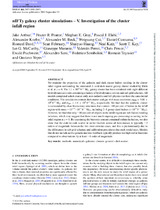nIFTy galaxy cluster simulations – V. Investigation of the cluster infall region

View/
Date
2016Author
Arthur, Jake
Pearce, Frazer R.
Gray, Meghan E.
Elahi, Pascal J.
Knebe, Alexander
Beck, Alexander M.
Cui, Weiguang
Cunnama, Daniel
Dave, Romeel
Metadata
Show full item recordAbstract
We examine the properties of the galaxies and dark matter haloes residing in the cluster
infall region surrounding the simulated cold dark matter galaxy cluster studied by Elahi
et al. at z = 0. The 1.1 × 1015 h−1M galaxy cluster has been simulated with eight different
hydrodynamical codes containing a variety of hydrodynamic solvers and sub-grid schemes. All
models completed a dark-matter-only, non-radiative and full-physics run from the same initial
conditions. The simulations contain dark matter and gas with mass resolution mDM = 9.01 ×
108 h−1M and mgas = 1.9 × 108 h−1M , respectively. We find that the synthetic cluster
is surrounded by clear filamentary structures that contain ∼60 per cent of haloes in the infall
region with mass ∼1012.5–1014 h−1M , including 2–3 group-sized haloes (>1013 h−1M ).
However, we find that only ∼10 per cent of objects in the infall region are sub-haloes residing
in haloes, which may suggest that there is not much ongoing pre-processing occurring in the
infall region at z = 0. By examining the baryonic content contained within the haloes, we also
show that the code-to-code scatter in stellar fraction across all halo masses is typically ∼2
orders of magnitude between the two most extreme cases, and this is predominantly due to
the differences in sub-grid schemes and calibration procedures that each model uses. Models
that do not include active galactic nucleus feedback typically produce too high stellar fractions
compared to observations by at least ∼1 order of magnitude.
